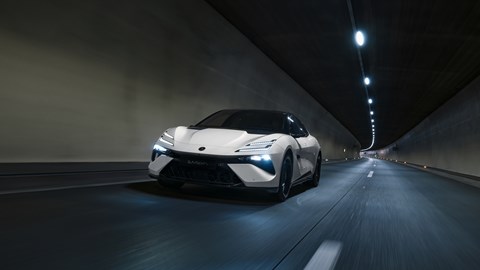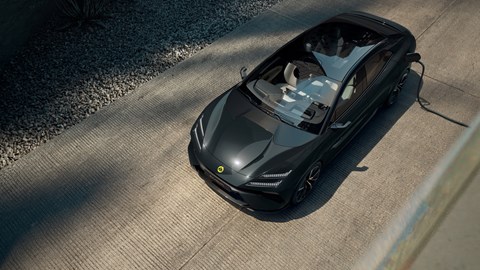► Lotus does a U-turn
► What’s next for EVs?
► And what’s next for Lotus?
In the risks section of the Lotus share prospectus published October 2023 lurks this prescient warning to potential investors: ‘If the market for luxury electric vehicles does not develop as we expect… our business, prospects, financial condition, and operating results will be affected.’
A little more than a year later, the risk has materialised alarmingly quickly and the luxury EV business is on its knees. Even in Lotus’s new home of China – cradle of the EV world – sales of high-end electric cars fell 50 per cent in 2024, CEO Feng Qingfeng admitted to investors on the company’s third-quarter earnings call.

That has whacked Lotus right in its growth trajectory. The Eletre SUV and then the Emeya saloon were supposed to be catnip to a luxury-loving populace more focused on coping with traffic jams than maximising corner g’s, but Lotus sales actually dropped six per cent in China in the first nine months of the year, shrinking below European sales figures.
Lotus’s reaction to discovering luxury customers are now declaring themselves too posh to plug is to say well, fine, we are not too proud to pivot.
The brand announced in November it would rip up its plan to go all-electric by 2028 and instead would launch ‘Hyper Hybrid’ models from 2026 that add a turbocharged combustion engine as a range extender.
‘If we went with our original plans, it wouldn’t suit every market globally, especially with the tariffs,’ Dan Balmer, the new CEO of Lotus Europe, told CAR. Handily the EU doesn’t include hybrids of any sort in its new China EV tariffs.
The new technology can be incorporated into the Electric Premium Architecture underpinning the Eletre and Emeya, giving them a range of almost 700 miles. Meanwhile the Type 134 smaller SUV, a rival for the Porsche Macan Electric that had been scheduled for a 2025 reveal, has been put on hold. ‘We’re taking the chance to look at the market again and read the room,’ Balmer said.

Lotus will also delay its electric sports car, Type 135, and extend the life of the Emira. Unmoved by the lure of lower running costs or purchase incentives, the rich are currently seeing very little advantages in switching to electric. ‘Luxury car engines are already very powerful, and the driving experience is quite similar, with eight-cylinder and 12-cylinder engines performing well,’ Feng admitted in an interview with the Wall Street Journal at the Guangzhou auto show in November.
The Hyper Hybrid is the answer, Lotus hopes. EREVs, or extended-range electric vehicles, have become big business at the premium end of the market in China. Li Auto’s blandly attractive SUVs with their big batteries mated to a back-up 1.5-litre engine have eaten into the market share of BMW, Mercedes and JLR.
The problem for a luxury manufacturer is that once the battery is depleted the four-cylinder engine is sweating hard to power a generator to keep the electric motor fed.
Lotus’s solution is the Dual Hyper Charging technology. Once the battery runs low mid-journey, the company’s ‘ultra-fast’ On-The-Drive Charging technology will provide a rapid top-up, theoretically retaining the same smooth, powerful electric experience for longer. ‘It will satisfy Lotus users’ pursuit of driving joy,’ Feng told analysts.

When the car is stopped, ‘flash-charging’ (by which Lotus simply means a quick visit to a plug-in charger) tops the battery up from 10 per cent to 80 per cent full in 10 minutes, according to the company. This is ‘similar to a battery swap’, Lotus says in reference to technology employed by Nio, another premium EV company fiercely competing for share among the plug-shy rich.
All this is enabled by a 900-volt electric architecture, upgraded from the 800-volt system in the electric-only Eletre and Emeya, two cars that already charge as fast as anything on the market at speeds of up to 340kW. The Hyper Hybrid won’t use the AMG four-cylinder unit currently available in the Emira, Balmer said, without saying what it will employ. It’s likely the engine will come from Horse, the Geely parent company’s new hybrid-focused engine business formed with Renault.
Lotus also wants to sell the tech to outside car makers, once it has given itself a head-start, Feng said.
Lotus’s precision U-turn is arguably only possible due to its relationship to Geely. The Chinese behemoth is busy recalibrating other formerly electric-only brands to react to its country’s new embrace of the plug-in hybrid in its various forms, including its Audi rival Zeekr and Smart, a 50/50 joint venture with Mercedes.
Despite falling short of its self-imposed targets, Lotus is in fact growing: 7617 sales in the first nine months of 2024, up 136 per cent from same period in the year before. For a company that has traditionally regarded anything over 2500 sales in a year as cause for celebration, these are clearly very different times, albeit unprofitable.
The share prospectus spoke of 47,000 sales in 2024 on the way to 150,000 by 2028. Even the heavily revised figure of 12,000 for 2024 was ‘definitely challenging’, Feng admitted. The bullish initial figures were ‘predicated off near-linear adoption in all markets’, Balmer said. ‘We’ve now recognised that it’s more of a market-share objective.’

Lotus, like many other car companies, is having to throttle back production, both in its Wuhan, China facility and Hethel, as it works through unsold inventory. The company even had to let 200 staff go at its Norfolk sports car facility due to weakened demand for the combustion-engined Emira, which accounted for just under half of sales in the first nine months of 2024. Balmer blamed weakened Emira demand on the ‘normal lifecycle’ of a three-year-old car. Meanwhile the first £2m Evija electric hypercars will be delivered in the second quarter of 2025, six years after the car’s unveiling.
The world has changed immeasurably since Geely bought 51 per cent of Lotus from Malaysia’s Proton in 2017. Most of the production promises Geely has made for Lotus it has largely delivered, including the new factory in Wuhan for the ‘lifestyle’ vehicles.
The cars too have largely lived up to their promise amid what’s arguably been an even more challenging brand renewal than Jaguar’s. As late as 2022 the company was still lauding its ‘sensible decision’ to swing for all-EV by 2028.
But a combination of government-level anti-China sentiment and a huge swing away from EVs among the super rich after initially embracing them has left Lotus with little choice but to activate Reinvention 2.0 and welcome back the combustion engine.